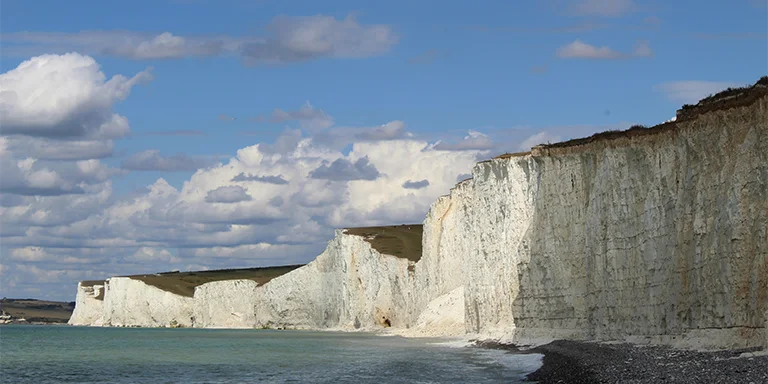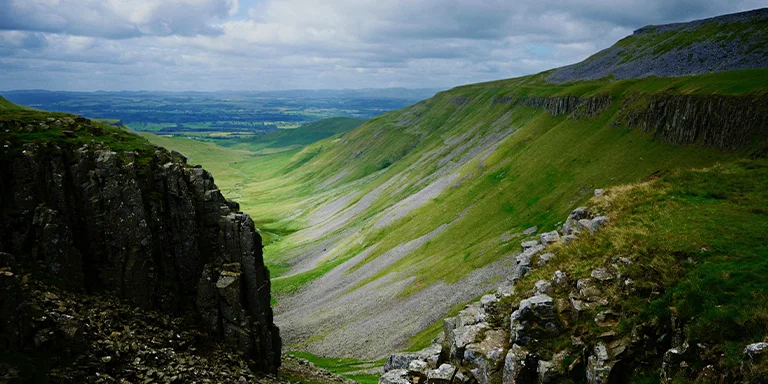

Backpacking in England offers immense variety for outdoor enthusiasts, from the rugged peaks of the Lake District to the windswept coastal paths of Cornwall, including popular destinations like the Cotswolds.
And that’s what this post is all about – backpacking in England. We’ll provide tips to help you prepare for backpacking in this diverse country as well as showcase the TOP 5 multi-day trails in England.
Interested? Let’s get started.
Top multi-day trips in England with resupply opportunities at least every two days:

Length: 185 mi / 298 km
Type: Point to point
Difficulty: Hard
Elevation Gain: 31 873 ft / 9715 m
Location: St Bees
Active Burn: 31 100 calories
More Details: See on AllTrails
The 185-mile Coast to Coast trail from St. Bees to Robin Hood’s Bay is one of England’s most iconic long-distance hikes. This epic journey traverses three stunning national parks – the Lake District, Yorkshire Dales, and North York Moors, offering hikers breathtaking scenery and a chance to immerse themselves in the diverse landscapes of northern England.
Along the rugged trail, you’ll encounter dramatic fells, rolling hills, and windswept moors, with opportunities to dip your shoes in both the Irish Sea and the North Sea. While the terrain can be challenging, with steep climbs and a lack of clear signposts, the adventure promises rewarding cultural encounters. You’ll pass through quaint villages, experiencing local traditions and warm hospitality.

Length: 101.1 mi / 162.7 km
Type: Point to point
Difficulty: Hard
Elevation Gain: 13 900 ft / 4237 m
Location: South Downs National Park
Active Burn: 16 700 calories
More Details: See on AllTrails
The 100-mile South Downs Way is a popular long-distance trail that takes you through the rolling hills and spectacular coastline of southern England. This challenging multi-day trek winds its way from Winchester to Eastbourne, passing through medieval villages, World War II sites, and the stunning landscapes of the South Downs National Park.
Highlights along the trail include the iconic Seven Sisters cliffs, offering breathtaking views of the English coastline. The route also provides opportunities for wild camping.
As you hike the South Downs Way, you’ll be treated to ever-changing vistas of rolling hills, lush meadows, and charming villages, offering a true immersion in the rich history and natural beauty of this region. Whether you’re an experienced trekker or a casual backpacker, this multi-day journey promises a memorable adventure.

Length: 85.5 mi / 137.6 km
Type: Point to point
Difficulty: Moderate
Elevation Gain: 7906 ft / 2410 m
Location: Wallsend
Active Burn: 13 200 calories
More Details: See on AllTrails
The 85.5-mile Hadrian’s Wall trail offers a unique opportunity to step back in time and experience the rich history of Roman Britain. This moderately challenging thru-hike follows the route of the ancient Roman wall, now a UNESCO World Heritage Site, across the heart of England.
As you embark on this journey, you’ll be treated to a diverse array of landscapes, from rolling countryside to vibrant cities like Newcastle and Carlisle. Along the way, you’ll encounter a wealth of Roman ruins and relics, providing a glimpse into the lives of the legions who once guarded this fortified frontier.
In our opinion this is the best hiking experience offers a rare opportunity to connect with the past while enjoying the beauty of the English countryside.

Length: 73.8 mi / 118.8 km
Type: Point to point
Difficulty: Hard
Elevation Gain: 13 582 ft / 4140 m
Location: Lake District National Park
Active Burn: 14 800 calories
More Details: See on AllTrails
The challenging 74-mile Cumbria Way winds through the heart of the picturesque Lake District, from Ulverston to Carlisle. Passing lakes, villages, remote moorlands, and farmlands, this point-to-point trail offers stunning views and diverse terrain.
The varied terrain, ranging from rugged paths to gentle farmlands, requires navigation skills and self-sufficiency due to changeable weather and lack of signage. The route provides a rewarding immersion in England’s famed Lake District National Park.
With proper planning, navigation skills, and a spirit of determination, you’ll be able to fully immerse yourself in the spectacular scenery and undisturbed tranquility of this iconic English wilderness.

Length: 259.6 mi / 417.8 km
Type: Point to point
Difficulty: Hard
Elevation Gain: 42 952 ft / 13 092 m
Location: Castleton
Active Burn: 45 200 calories
More Details: See on AllTrails
The extremely challenging 260-mile Pennine Way is a renowned long-distance trail traversing the rugged Pennine hills from Edale to Kirk Yetholm. Requiring navigation skills and preparation for changeable weather at high elevations, this route is only for experienced backpackers.
As you make your way along the trail, you’ll pass through wild moorlands and encounter panoramic peaks like the iconic Pen-y-Ghent, providing an epic adventure across the “backbone of England.” The magnificent yet unforgiving terrain showcases the remote beauty of northern England.
Proper planning, gear, and a deep respect for the unpredictable conditions are essential to tackle this demanding trek safely. However, for those willing to embrace the challenge, the rewards are immense.
In England, the weather can be quite changeable, and rain is common. Here’s a general overview of the year-round weather:
Before you decide what gear to bring, check out the average annual weather data recorded in England (Kendal):
| Jan | Feb | Mar | Apr | May | Jun | Jul | Aug | Sep | Oct | Nov | Dec | |
|---|---|---|---|---|---|---|---|---|---|---|---|---|
| High °F | 43 | 43 | 47 | 52 | 57 | 62 | 65 | 64 | 60 | 54 | 48 | 44 |
| Low °F | 36 | 36 | 37 | 40 | 45 | 50 | 54 | 53 | 50 | 45 | 40 | 37 |
| Rain D* | 14 | 11 | 11 | 9 | 10 | 10 | 11 | 12 | 11 | 13 | 14 | 14 |
Not sure if England is right for you?
Don’t forget to check out our backpacking guides for Wales and Scotland.
In England, lighting campfires while backpacking is generally prohibited without landowner permission. Fires are only permitted in designated areas in national parks. There are some exceptions for small cooking fires using gas stoves in secluded spots, but you should avoid lighting open wood fires while backpacking across private or protected land due to fire risk and smoke pollution.
When backpacking nature trails in England, be a cautious backpacker prepared for the changeable weather by packing warm layers and waterproof outdoor gear. Carry a map, compass, GPS device, and mobile phone to avoid getting lost while walking across beautiful landscapes. Tell someone your hiking plans and check in regularly from the tent or campsites. Stick to established walking trails and avoid trespassing on private farmland. Beware of steep, muddy, or uneven terrain that can lead to injury. Watch for poisonous adders and irritant plants like giant hogweed while exploring the countryside. At night, set up your tent discreetly and avoid drawing attention. Overall, use caution, trust your instincts, and put safety first when backpacking and exploring England’s trails and stunning landscapes.
The most common wildlife encounters when backpacking in England are with farm animals like cows, sheep, and horses. It’s best not to startle them, so move slowly and give them ample space. For potentially dangerous animals like adders, back away slowly and give them a wide berth. Avoid feeding or approaching wildlife, as it can disrupt their natural behaviors. If you bring a dog, keep it leashed and under control.
U.S. citizens can visit England for up to 6 months without a visa for purposes of tourism, visiting family or friends, or business trips. Travelers simply need a valid U.S. passport to enter the country. As long as you do not plan to work, study, or stay beyond your allowed visit, and can support yourself financially, you can enjoy visa-free travel to England. Just be sure your passport is valid for at least 6 months beyond your planned departure. With proper documentation, Americans can conveniently explore historic sites, lively cities, and scenic landscapes across England without the need for a traditional visa.